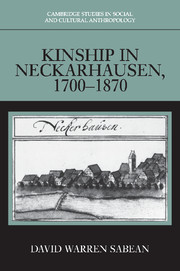Book contents
- Frontmatter
- Contents
- List of tables
- Abbreviations
- Abbreviations of sources
- On reading kinship diagrams
- Glossary
- Preface
- Introduction
- Cohort I (1700–1709)
- Cohort II (1740–1749)
- 9 Restructuring the system of alliance
- 10 Village politics at midcentury
- Cohort III (1780–1789)
- Cohort IV (1820–1829)
- Cohort V (1860–1869)
- Conclusion
- Appendix
- Bibliography
- General index
- Index of villagers
9 - Restructuring the system of alliance
Published online by Cambridge University Press: 04 August 2010
- Frontmatter
- Contents
- List of tables
- Abbreviations
- Abbreviations of sources
- On reading kinship diagrams
- Glossary
- Preface
- Introduction
- Cohort I (1700–1709)
- Cohort II (1740–1749)
- 9 Restructuring the system of alliance
- 10 Village politics at midcentury
- Cohort III (1780–1789)
- Cohort IV (1820–1829)
- Cohort V (1860–1869)
- Conclusion
- Appendix
- Bibliography
- General index
- Index of villagers
Summary
During the middle decades of the eighteenth century, kinship changed dramatically. Some people in the village began to marry cousins and to call upon other cousins to be godparents. An alliance system emerged that favored consanguineal relatives over affinal ones, but the connection between the two categories is complicated, and the one was frequently reinforced by the other. When a man or a woman married a cousin, other cousins consequently became in-laws and were then frequently prepared to coordinate their activities in new ways. The innovation lies in the fact that cousin marriages allowed alliances forged in one generation to be replicated in another. Not all sections of the village adopted the new practice at once, and not until the early decades of the nineteenth century was it generalized, although even then the kinds of cousins chosen correlated closely with different social strata. The new system lasted in its essential form until the middle of the nineteenth century, when the systematic alliance of agnatically constructed “lines” gave way to a form of exchange mediated by women.
At this point, it would be tedious and not especially rewarding to go over each indicator of kin interaction to show the precise departures and continuities at every point. A fuller discussion of the intricacies of the system – once it was fully in place and subject to a half century of experience – will be taken up in the section on the third cohort (centered on the 1780s).
- Type
- Chapter
- Information
- Kinship in Neckarhausen, 1700–1870 , pp. 170 - 191Publisher: Cambridge University PressPrint publication year: 1997



